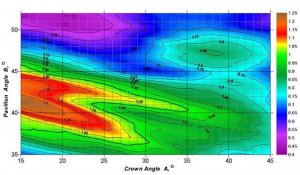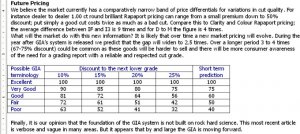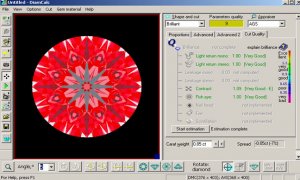- Joined
- Sep 3, 2000
- Messages
- 6,694
Let's just say several 1.00ct round diamonds of various proportions happen to give us nearly equally high light return measures. Due to their different cutting styles they are all different depth percentage stones.
Just suppose a hypothetical Tolkowsky range diamond in this group has a depth of 60.5% and happens to have a diamater of 6.4mm. The other diamonds ain this group are all of different depths and diameters, yet they all still weigh 1.00ct.
1. Do you think other diamonds in this group of stones with SMALLER diameters and DEEPER depths are worth a bit less, more or are equal in value to the hypothetical Tolkowsky range diamond?
2. Do you think other diamonds in this group with LARGER diameters and LESS depth are worth less, more or equal to the value of the hypothetical Tolkowsky range diamond?
3. If the depth becomes extremely deep or extremely shallow, yet the light performance remains virtually equal, due to very smart cutting, is there a point where the value will go down due to lack of visual size or lack of durability?
Where do you think this downturn of value would happen?
What depth or lack of depth are a crucial breaks in terms of value?
4. Lastly, what depth or lack of depth constitutes a step down from IDEAL cut no matter how great the light return measure is?
THANK YOU FOR ANY AND ALL REPLIES....
Just suppose a hypothetical Tolkowsky range diamond in this group has a depth of 60.5% and happens to have a diamater of 6.4mm. The other diamonds ain this group are all of different depths and diameters, yet they all still weigh 1.00ct.
1. Do you think other diamonds in this group of stones with SMALLER diameters and DEEPER depths are worth a bit less, more or are equal in value to the hypothetical Tolkowsky range diamond?
2. Do you think other diamonds in this group with LARGER diameters and LESS depth are worth less, more or equal to the value of the hypothetical Tolkowsky range diamond?
3. If the depth becomes extremely deep or extremely shallow, yet the light performance remains virtually equal, due to very smart cutting, is there a point where the value will go down due to lack of visual size or lack of durability?
Where do you think this downturn of value would happen?
What depth or lack of depth are a crucial breaks in terms of value?
4. Lastly, what depth or lack of depth constitutes a step down from IDEAL cut no matter how great the light return measure is?
THANK YOU FOR ANY AND ALL REPLIES....











300x240.png)